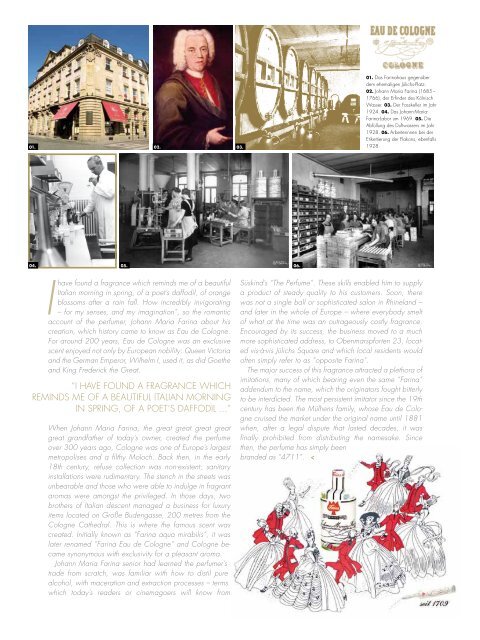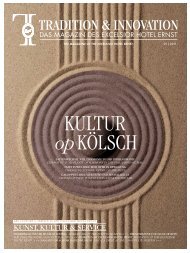taku - traditiOn & innOvatiOn
taku - traditiOn & innOvatiOn
taku - traditiOn & innOvatiOn
Erfolgreiche ePaper selbst erstellen
Machen Sie aus Ihren PDF Publikationen ein blätterbares Flipbook mit unserer einzigartigen Google optimierten e-Paper Software.
01. 02. 03.<br />
04. 05. 06.<br />
I<br />
have found a fragrance which reminds me of a beautiful<br />
Italian morning in spring, of a poet’s daffodil, of orange<br />
blossoms after a rain fall. How incredibly invigorating<br />
– for my senses, and my imagination”, so the romantic<br />
account of the perfumer, Johann Maria Farina about his<br />
creation, which history came to know as Eau de Cologne.<br />
For around 200 years, Eau de Cologne was an exclusive<br />
scent enjoyed not only by European nobility: Queen Victoria<br />
and the German Emperor, Wilhelm I, used it, as did Goethe<br />
and King Frederick the Great.<br />
“I HAVE FOUND A FRAGRANCE WHICH<br />
REMINDS ME OF A BEAUtIFUL ItALIAN MORNING<br />
IN SPRING, OF A POEt‘S DAFFODIL ...”<br />
When Johann Maria Farina, the great great great great<br />
great grandfather of today’s owner, created the perfume<br />
over 300 years ago, Cologne was one of Europe’s largest<br />
metropolises and a filthy Moloch. Back then, in the early<br />
18th century, refuse collection was non-existent; sanitary<br />
installations were rudimentary. The stench in the streets was<br />
unbearable and those who were able to indulge in fragrant<br />
aromas were amongst the privileged. In those days, two<br />
brothers of Italian descent managed a business for luxury<br />
items located on Große Budengasse, 200 metres from the<br />
Cologne Cathedral. This is where the famous scent was<br />
created. Initially known as “Farina aqua mirabilis”, it was<br />
later renamed “Farina Eau de Cologne” and Cologne became<br />
synonymous with exclusivity for a pleasant aroma.<br />
Johann Maria Farina senior had learned the perfumer’s<br />
trade from scratch, was familiar with how to distil pure<br />
alcohol, with maceration and extraction processes – terms<br />
which today’s readers or cinemagoers will know from<br />
01. Das Farinahaus gegenüber<br />
dem ehemaligen Jülichs-Platz.<br />
02. Johann Maria Farina (1685 –<br />
1766), der Erfinder des Kölnisch<br />
Wasser. 03. Der Fasskeller im Jahr<br />
1924. 04. Das Johann-Maria-<br />
Farina-Labor um 1969. 05. Die<br />
Abfüllung des Duftwassers im Jahr<br />
1928. 06. Arbeiterinnen bei der<br />
Etikettierung der Flakons, ebenfalls<br />
1928.<br />
Süskind’s “The Perfume”. These skills enabled him to supply<br />
a product of steady quality to his customers. Soon, there<br />
was not a single ball or sophisticated salon in Rhineland –<br />
and later in the whole of Europe – where everybody smelt<br />
of what at the time was an outrageously costly fragrance.<br />
Encouraged by its success, the business moved to a much<br />
more sophisticated address, to Obenmarspforten 23, located<br />
vis-à-vis Jülichs Square and which local residents would<br />
often simply refer to as “opposite Farina”.<br />
The major success of this fragrance attracted a plethora of<br />
imitations, many of which bearing even the same “Farina”<br />
addendum to the name, which the originators fought bitterly<br />
to be interdicted. The most persistent imitator since the 19th<br />
century has been the Mülhens family, whose Eau de Cologne<br />
cruised the market under the original name until 1881<br />
when, after a legal dispute that lasted decades, it was<br />
finally prohibited from distributing the namesake. Since<br />
then, the perfume has simply been<br />
branded as “4711”.



